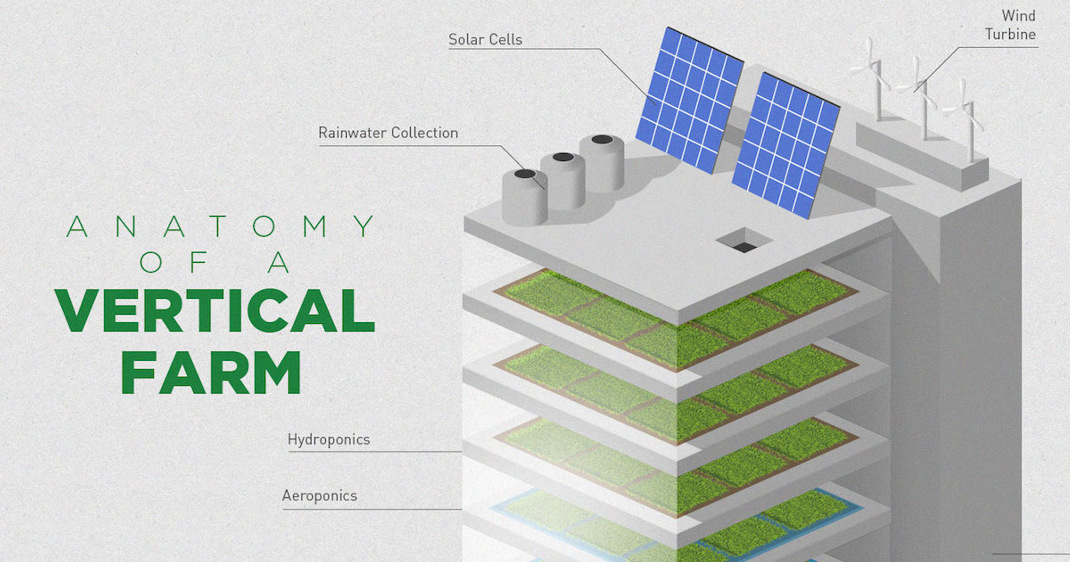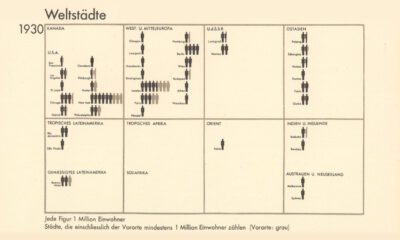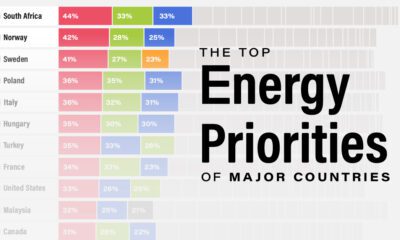Technology
How Vertical Farming Works

Image courtesy of: Futurism
How Vertical Farming Works
By 2050, there will be 3 billion more people in existence, and close to 80% of the world’s population will live in urban areas. The demand for food will be unprecedented, and we will need to figure out how to get food to the cities in the most effective way.
Enter vertical farming – the idea of building entire skyscrapers occupied with vertically-stacked farms that produce crops twice as fast, while using 40% less power, having 80% less food waste, and using 99% less water than outdoor fields.
Is it feasible, or is it a futuristic money pit?
The Advantages of Vertical Farming
There’s no question that vertical farming has enticing potential benefits.
The first is yield. Vertical farming can produce crops year-round, which increases production efficiency by a multiplier of 4 to 6 depending on the crop. There would also be less wastage and spoilage, as most of the crops could be sold fresh in a market or restaurant from the same facility. It’s estimated that 30% of harvested crops today are lost due to spoilage or infestation.
Secondly, vertical farming has less risk associated with it. Big weather events such as floods, droughts, or storms can put a dent into agricultural activity fast, costing farmers billions of dollars. Farming indoors can reduce the risk of these types of events to as low as possible.
Lastly, vertical farming is inherently more sustainable. By stacking farms vertically, the productivity per unit of land can be many times higher and arable land can be saved for other purposes. Further, there are no transportation costs to get the crops to market, and energy and water can be recycled within the building. Methane digesters can even help convert organic waste to energy to help power the building.
On paper, vertical farming seems to have big advantages.
Too Good to be True?
Critics of vertical farming question the potential profitability of commercial operations.
They say the capital expenditures, as well as the additional energy costs for lighting and heating, could outweigh any benefits. Building complex plumbing and elevator systems to distribute food and water throughout a 30-story building is not easy.
Meanwhile, for traditional farming operations, both sunlight and heat are free. Irrigation is generally cheap as well.
The benefits of vertically-stacked farms would have to outweigh the increased costs. With billions of new people being added to cities over the next decades, this could come be sooner than later.
Original graphic by: Futurism
Technology
All of the Grants Given by the U.S. CHIPS Act
Intel, TSMC, and more have received billions in subsidies from the U.S. CHIPS Act in 2024.

All of the Grants Given by the U.S. CHIPS Act
This was originally posted on our Voronoi app. Download the app for free on iOS or Android and discover incredible data-driven charts from a variety of trusted sources.
This visualization shows which companies are receiving grants from the U.S. CHIPS Act, as of April 25, 2024. The CHIPS Act is a federal statute signed into law by President Joe Biden that authorizes $280 billion in new funding to boost domestic research and manufacturing of semiconductors.
The grant amounts visualized in this graphic are intended to accelerate the production of semiconductor fabrication plants (fabs) across the United States.
Data and Company Highlights
The figures we used to create this graphic were collected from a variety of public news sources. The Semiconductor Industry Association (SIA) also maintains a tracker for CHIPS Act recipients, though at the time of writing it does not have the latest details for Micron.
| Company | Federal Grant Amount | Anticipated Investment From Company |
|---|---|---|
| 🇺🇸 Intel | $8,500,000,000 | $100,000,000,000 |
| 🇹🇼 TSMC | $6,600,000,000 | $65,000,000,000 |
| 🇰🇷 Samsung | $6,400,000,000 | $45,000,000,000 |
| 🇺🇸 Micron | $6,100,000,000 | $50,000,000,000 |
| 🇺🇸 GlobalFoundries | $1,500,000,000 | $12,000,000,000 |
| 🇺🇸 Microchip | $162,000,000 | N/A |
| 🇬🇧 BAE Systems | $35,000,000 | N/A |
BAE Systems was not included in the graphic due to size limitations
Intel’s Massive Plans
Intel is receiving the largest share of the pie, with $8.5 billion in grants (plus an additional $11 billion in government loans). This grant accounts for 22% of the CHIPS Act’s total subsidies for chip production.
From Intel’s side, the company is expected to invest $100 billion to construct new fabs in Arizona and Ohio, while modernizing and/or expanding existing fabs in Oregon and New Mexico. Intel could also claim another $25 billion in credits through the U.S. Treasury Department’s Investment Tax Credit.
TSMC Expands its U.S. Presence
TSMC, the world’s largest semiconductor foundry company, is receiving a hefty $6.6 billion to construct a new chip plant with three fabs in Arizona. The Taiwanese chipmaker is expected to invest $65 billion into the project.
The plant’s first fab will be up and running in the first half of 2025, leveraging 4 nm (nanometer) technology. According to TrendForce, the other fabs will produce chips on more advanced 3 nm and 2 nm processes.
The Latest Grant Goes to Micron
Micron, the only U.S.-based manufacturer of memory chips, is set to receive $6.1 billion in grants to support its plans of investing $50 billion through 2030. This investment will be used to construct new fabs in Idaho and New York.
-

 Debt1 week ago
Debt1 week agoHow Debt-to-GDP Ratios Have Changed Since 2000
-

 Markets2 weeks ago
Markets2 weeks agoRanked: The World’s Top Flight Routes, by Revenue
-

 Countries2 weeks ago
Countries2 weeks agoPopulation Projections: The World’s 6 Largest Countries in 2075
-

 Markets2 weeks ago
Markets2 weeks agoThe Top 10 States by Real GDP Growth in 2023
-

 Demographics2 weeks ago
Demographics2 weeks agoThe Smallest Gender Wage Gaps in OECD Countries
-

 United States2 weeks ago
United States2 weeks agoWhere U.S. Inflation Hit the Hardest in March 2024
-

 Green2 weeks ago
Green2 weeks agoTop Countries By Forest Growth Since 2001
-

 United States2 weeks ago
United States2 weeks agoRanked: The Largest U.S. Corporations by Number of Employees















